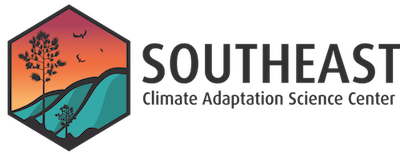A Guide to Understanding How Natural Ecosystems will be Transformed in the Southeast
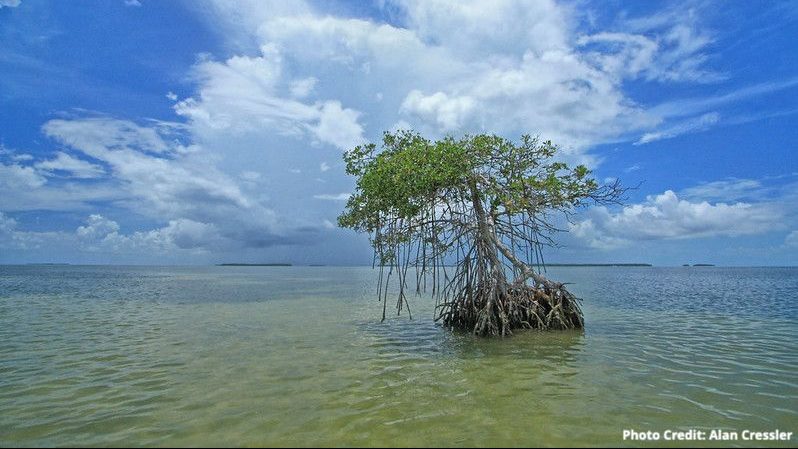
A Guide to Understanding
How Natural Ecosystems will be Transformed
in the Southeast
NCA4 Webinar Series – Key Message 3
Fourth National Climate Assessment (NCA4) Webinar Series
Below is a brief overview of this week’s webinar topic – Key Message 3: Natural Ecosystems will be Transformed.
Wednesday, November 20, 2019, 12 pm ET
Key Message 3: Natural Ecosystems will be Transformed
“The Southeast’s diverse natural systems, which provide many benefits to society, will be transformed by climate change (very likely, high confidence). Changing winter temperature extremes, wildfire patterns, sea levels, hurricanes, floods, droughts, and warming ocean temperatures are expected to redistribute species and greatly modify ecosystems (very likely, high confidence). As a result, the ecological resources that people depend on for livelihood, protection, and well-being are increasingly at risk, and future generations can expect to experience and interact with natural systems that are much different than those that we see today (very likely, high confidence).”
For more detail related to this Key Message, also see:
NCA4, Chapter 7: Ecosystems, Ecosystem Services, and Biodiversity
Drivers of Ecosystem Impacts in the Southeast: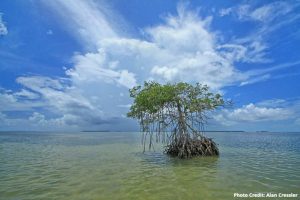
– Warming Winter Temperature Extremes
– Changing Patterns of Fire
– Rising Sea Levels and Hurricanes
– Drought and Extreme Rainfall
– Warming Ocean Temperatures
Figure 19.15 Projected Changes in Plant Hardiness Zones
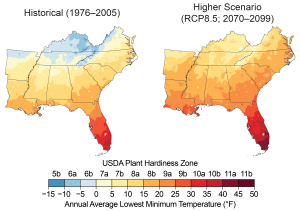 Increasing winter temperatures are expected to result in a northward shift of the zones conducive to growing various types of plants, known as plant hardiness zones. These maps show the mean projected changes in the plant hardiness zones, as defined by the U.S. Department of Agriculture, by the late 21st century (2070–2099) under a higher scenario (RCP8.5). The USDA plant hardiness zones are based on the average lowest minimum temperature for the year, divided into increments of 5°F. Based on these projected changes, freeze-sensitive plants, like oranges, papayas, and mangoes, would be able to survive in new areas. Sources: NOAA NCEI and CICS-NC.
Increasing winter temperatures are expected to result in a northward shift of the zones conducive to growing various types of plants, known as plant hardiness zones. These maps show the mean projected changes in the plant hardiness zones, as defined by the U.S. Department of Agriculture, by the late 21st century (2070–2099) under a higher scenario (RCP8.5). The USDA plant hardiness zones are based on the average lowest minimum temperature for the year, divided into increments of 5°F. Based on these projected changes, freeze-sensitive plants, like oranges, papayas, and mangoes, would be able to survive in new areas. Sources: NOAA NCEI and CICS-NC.
(Link to Figure 19.15 | Downloadable PDF)
Figure 19.16: Salt Marsh Conversion to Mangrove Forest
 Where tropical and temperate ecosystems meet, warmer winter temperatures can lead to large ecological changes such as mangrove forest replacement of salt marshes along the Gulf and Atlantic Coasts. Mangrove forests are sensitive to freezing temperatures and are expected to expand northward at the expense of salt marshes. The figure shows the relationship between temperature and the percentage area dominated by mangrove forests. Mangrove expansion would entail a grassland-to-forest conversion, which would affect fish and wildlife habitat and many societal benefits. Source: adapted from Osland et al. 2013.
Where tropical and temperate ecosystems meet, warmer winter temperatures can lead to large ecological changes such as mangrove forest replacement of salt marshes along the Gulf and Atlantic Coasts. Mangrove forests are sensitive to freezing temperatures and are expected to expand northward at the expense of salt marshes. The figure shows the relationship between temperature and the percentage area dominated by mangrove forests. Mangrove expansion would entail a grassland-to-forest conversion, which would affect fish and wildlife habitat and many societal benefits. Source: adapted from Osland et al. 2013.
(Link to Figure 19.16 | Downloadable PDF)
19.17 Transitioning Coastal Ecosystems
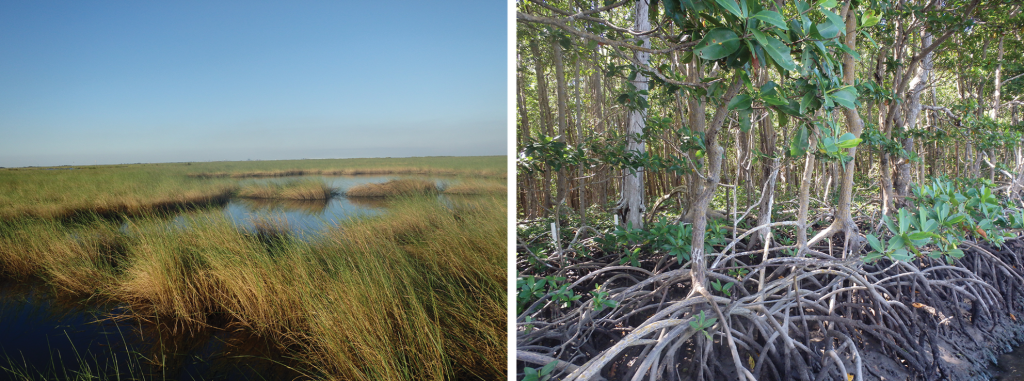 In Louisiana and parts of northern Florida, future coastal wetlands are are expected to look and function more like the mangrove-dominated systems currently present in South Florida and the Caribbean. Like salt marshes (left), mangrove forests (right) provide coastal protection against wind and waves (Ch. 20: U.S. Caribbean, KM 2). Photo credit: Michael Osland.
In Louisiana and parts of northern Florida, future coastal wetlands are are expected to look and function more like the mangrove-dominated systems currently present in South Florida and the Caribbean. Like salt marshes (left), mangrove forests (right) provide coastal protection against wind and waves (Ch. 20: U.S. Caribbean, KM 2). Photo credit: Michael Osland.
(Downloadable PDF)
CASE STUDY: Prescribed Fire

With wildfire projected to increase in the Southeast, prescribed fire (the purposeful ignition of low-intensity fires in a controlled setting), remains the most effective tool for reducing wildfire risk. Department of Defense (DoD) lands represent the largest reservoirs of biodiversity and native ecosystems in the region. Military activities are a frequent source of wildfires, but increases in prescribed fire acres show a corresponding decrease in wildfire ignitions for DoD. Climate resilience by DoD is further achieved through restoration of native longleaf pine forests that occupy a wide range of site types, including wetland and well-drained soils—the latter leading many to characterize this forest as being drought resistant. In addition to proactive adaptation through prescribed fire, DoD has been a leader in climate strategies that include regional conservation planning, ecosystem management, endangered species recovery, and research funding.
Figure 19.19: (top) A helicopter drops water on a 1,500-hectare wildfire on Hurlburt Field (Eglin Air Force Base) in Florida in June of 2012. (bottom) The increased use of prescribed fire at Ft. Benning, Georgia, led to a decrease in wildfire occurrence from 1982 to 2012. Photo credit: Kevin Hiers, Tall Timbers. Figure source: adapted from Addington et al. 2015. Reprinted by permission of CSIRO Australia, ©CSIRO.
(Link to Figure 19.19 | Downloadable PDF)
Additional Case Studies from the U.S. Climate Resilience Toolkit:
– Case Study: Setting Conservation Priorities for Preserving Wildlife Habitat
– Case Study: Incorporating Climate Change Into a New Forest Management Plan
Evidence, Likelihood, and Confidence for Key Message 3
Evidence of impacts to the Southeast are supported by the geography of the region, which contains a large number of cities located at or below sea level at an increased risk of flooding. Additionally, the natural climate of the Southeast provides a conducive atmosphere for health issues including the spread of disease. Uncertainties include population projections, shifts in immigration or migration rates, and shifting demographics. See more.
SE CASC publications relevant to this Key Message include:
- Temperature thresholds for black mangrove (Avicennia germinans) freeze damage, mortality, and recovery in North America: refining tipping points for range expansion in a warming climate (2019)
- Mangrove forests in a rapidly changing world: Global change impacts and conservation opportunities along the Gulf of Mexico coast (2018)
- Macroclimatic change expected to transform coastal wetland ecosystems this century (2017)
- Barriers to and opportunities for landward migration of coastal wetlands with sea‐level rise (2016)
- The physiology of mangrove trees with changing climate (2016)
- Climatic controls on the global distribution, abundance, and species richness of mangrove forests (2016)
- Mangrove expansion and contraction at a poleward range limit: climate extremes and land‐ocean temperature gradients (2016)
- Salt marsh‐mangrove ecotones: using structural gradients to investigate the effects of woody plant encroachment on plant–soil interactions and ecosystem carbon pools (2016)
- Beyond just sea‐level rise: considering macroclimatic drivers within coastal wetland vulnerability assessments to climate change (2015)
- Winter climate change and coastal wetland foundation species: salt marshes vs. mangrove forests in the southeastern United States (2012)
SE CASC funding and researchers have implemented projects relevant to this Key Message:
- Ecological Implications of Mangrove Forest Migration in the Southeastern United States.
Project details. - Enhancing the Adaptive Capacity of Coastal Wetlands in the Face of Sea-Level Rise and Coastal Development. Project details.
- Identifying the Ecological and Management Implications of Mangrove Migration in the Northern Gulf of Mexico. Project details.
- Assessing Climate-Sensitive Ecosystems in the Southeastern United States. Project details.
View a Guide to Understanding the Southeast Chapter of the NCA4
- Categories:
